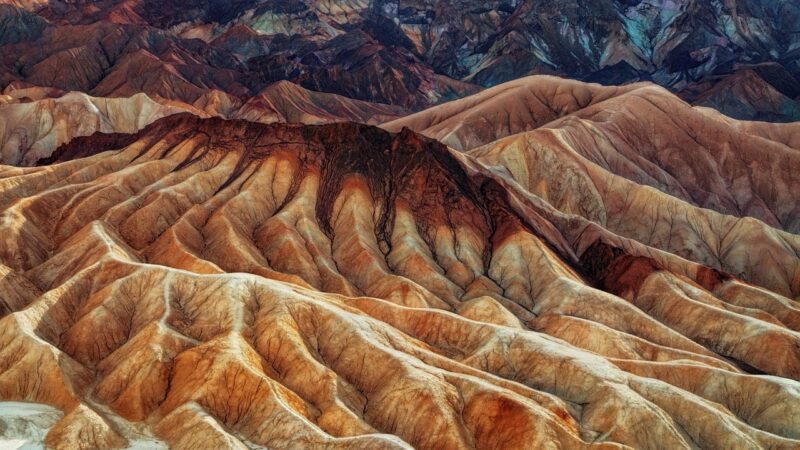The Mystery of Moving Rocks in Death Valley: A Geologic Puzzle
November 15, 2024

Death Valley, known for its extreme conditions and breathtaking landscapes, holds a curious geologic phenomenon that has intrigued scientists and adventurers alike – the moving rocks. This mysterious occurrence, observed at the Racetrack Playa, has puzzled many over the years. How can stones weighing hundreds of pounds seemingly glide across the arid desert floor, leaving behind long trails? In this article, we will explore the fascinating science behind this phenomenon, the theories that have emerged, and the implications of understanding such a natural enigma.
1. The Setting: Racetrack Playa
Located in California’s Death Valley National Park, Racetrack Playa is a dry lake bed that stretches approximately 2.5 miles long and 1 mile wide. Surrounded by picturesque mountains, its flat, dry surface becomes the stage for a majestic geological show. The playa experiences minimal rainfall, making it one of the hottest places on Earth, but its seemingly barren landscape hides a rich geological history.
The rocks here vary in size, some only a few ounces, while others can weigh over 700 pounds. What sets these rocks apart is their unique ability to move without any apparent force acting upon them, a mystery that has captivated visitors for decades.
2. The Phenomenon of Movement
Reports of the rocks moving date back as early as the 1900s. Witnesses have noted the peculiar trails left behind by these stones, often extending several meters in length. Some of these trails appear straight, while others are serpentine, indicating a change in the direction of the rocks as they glide.
The stones move unpredictably, and at certain times of the year, visitors can observe the freshly scoured tracks in the dry earth. But what causes these heavy rocks to shift? The answer lies in a combination of environmental factors, primarily involving rain, ice, and the wind.
3. The Scientific Explanation
For decades, scientists have proposed various theories to explain this phenomenon:
a. The Role of Rain and Ice
Research conducted in the early 2010s provided strong evidence for one of the most plausible explanations. After a rare rainfall, water collects on the surface and can even form a thin layer of ice at night when temperatures drop. As the sun rises, this ice layer melts into a slippery film that creates the perfect conditions for the rocks to slide.
Winds can then push the rocks, allowing them to glide across the wet, slick surface. In fact, scientists have recorded instances of rocks moving at speeds up to 15 meters per minute.
b. The Influence of Wind
Wind also plays a crucial role in this spectacle. In addition to pushing the rocks during icy conditions, sustained winds can gradually shift the lighter stones over time. The combination of wind and the unique geological makeup of the area creates optimal conditions for the movement of these stones.
Alongside documented studies, researchers used GPS sensors to monitor the rocks’ movements, dispelling countless myths and speculations surrounding this phenomenon.
4. The Importance of Understanding Moving Rocks
Understanding how and why these rocks move is significant not just for academic curiosity, but it also provides insights into broader geological processes. Here are a few benefits of this understanding:
- Geological Research: The study of moving rocks contributes to our understanding of sediment transport, erosion, and other geological processes in dry lakebed environments.
- Climate Insights: Investigating this phenomenon helps scientists analyze patterns in climate changes, particularly in arid areas where water presence dramatically alters landscape dynamics.
- Visitor Education: The mystery attracts thousands of tourists each year, and educated visitors are likely to foster a greater appreciation for natural wonders and the importance of preservation.
With ongoing research and technological advancements, scientists hope to uncover even more about the mysteries of Racetrack Playa and the workings of our planet.
5. Responsible Tourism: Protecting the Playa
The natural beauty and mystery of Racetrack Playa have led to increased foot traffic over the years, raising concerns about the preservation of this unique ecosystem. To minimize human impact and preserve the playa’s delicate environment:
- Stay on Designated Paths: When visiting, always stay on marked paths to avoid creating unauthorized trails and disturbing the delicate surface.
- Respect Warning Signs: Pay attention to park guidelines and signs that designate areas needing protection.
- Leave No Trace: Ensure all trash and belongings are taken back with you, maintaining the natural environment for future generations.
By becoming responsible stewards of this stunning location, we ensure that the mystery of the moving rocks continues to captivate and inspire future explorers.
Conclusion
The moving rocks of Death Valley present an extraordinary geologic puzzle, reminding us of the complex processes that govern our natural world. Although scientific explanations have shed light on this mystery, the allure of nature’s wonders continues to inspire curiosity in all who visit.
As we strive to understand and respect these natural phenomena, we should also celebrate the beautiful mysteries that the Earth has to offer. The moving rocks at Racetrack Playa are not just stones; they are symbols of the continuous dynamic processes shaping our planet, beckoning us to delve deeper into the mysteries of geology and beyond.







